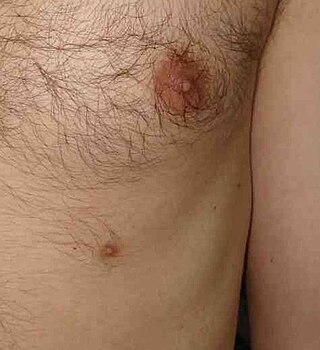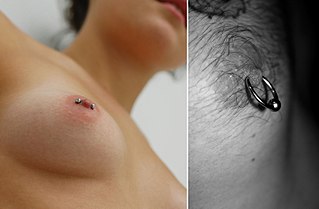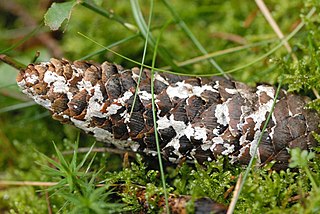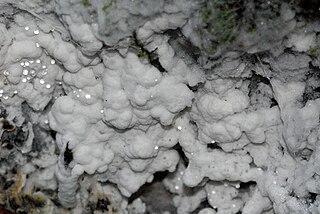
The breast is one of two prominences located on the upper ventral region of a primate's torso. Both females and males develop breasts from the same embryological tissues.

The nipple is a raised region of tissue on the surface of the breast from which, in females, milk leaves the breast through the lactiferous ducts to feed an infant. The milk can flow through the nipple passively or it can be ejected by smooth muscle contractions that occur along with the ductal system. Male mammals also have nipples but without the same level of function, and often surrounded by body hair.

An erogenous zone is an area of the human body that has heightened sensitivity, the stimulation of which may generate a sexual response, such as relaxation, sexual fantasies, sexual arousal and orgasm.

A supernumerary nipple is an additional instance of nipple occurring in mammals, including humans. They are often mistaken for moles. Studies variously report the prevalence of supernumerary nipples as approximately 1 in 18 and 1 in 40.

A nipple piercing is a type of body piercing, centered usually at the base of the nipple. It can be pierced at any angle but is usually done horizontally or, less often, vertically. It is also possible to place multiple piercings on top of one another.

A nipple clamp is a type of sex toy that is applied to a person's nipples to pinch them. Varieties of nipple clamp include clothes-pin-style, tweezer and clover. Nipple clamps are used to cause pain in the nipples as part of certain BDSM activities. They are also used to produce erotic stimulation as part of nipple play. In this context they are not primarily used to produce pain but rather to increase nipple sensation. Their use traps blood in the nipples, increasing the sensitivity of the nipple. The sexologist Carol Queen says that "clamps are also very useful for hands-free nipple play".

A nipple shield is a piece of body jewelry worn on the nipple, partially or fully covering the areola. The shield encircles the nipple, and can be attached by several means, including suction, friction and the action of glue, but is most often held in place by a nipple piercing. Usually, its primary intent is to lift, highlight, and ornament the nipple, as well as the whole breast, much as other pieces of jewelry do for other parts of the body.

Micromastia is a medical term describing the postpubertal underdevelopment of a woman's breast tissue. Just as it is impossible to define 'normal' breast size, there is no objective definition of micromastia. Breast development is commonly asymmetric and one or both breasts may be small. This condition may be a congenital defect associated with underlying abnormalities of the pectoral muscle, related to trauma or it may be a more subjective aesthetic description.

Fissure of the nipple, colloquially referred to as "jogger's nipple", is a condition that is the result of chafing of one or both nipples. This can occur in both men and women during physical exercise such as long-distance running where there is prolonged friction between the nipple and clothing. The issue is also commonly seen in surfers who do not wear rash guards or wetsuits.

Male chest reconstruction refers to any of various surgical procedures to masculinise the chest by removing breast tissue or altering the nipples and areolae. Male chest reconstruction may be performed in cases of gynecomastia and gender dysphoria. Transmasculine people may pursue chest reconstruction, also known as top surgery, as part of transitioning.
Amastia refers to a rare clinical anomaly in which both internal breast tissue and the visible nipple are absent on one or both sides. It affects both men and women. Amastia can be either isolated or comorbid with other syndromes, such as ectodermal dysplasia, Syndactyly and lipoatrophic diabetes. This abnormality can be classified into various types, and each could result from different pathologies. Amastia differs from amazia and athelia. Amazia is the absence of one or both mammary glands but the nipples remain present, and athelia is the absence of one or both nipples, but the mammary gland remains.
Amastia refers to a condition where one or both of the mammary glands is absent. This may occur either congenitally or iatrogenically. Amazia can be treated with breast implants.

"Nipple to the Bottle" is a single by the Jamaican singer, model and actress Grace Jones, released in 1982.

Atheliaceae is a family of corticioid fungi placed under the monotypic order Atheliales. Both the order and the family were described by Walter Jülich in 1981. According to a 2008 estimate, the family contains 20 genera and approximately 100 species. However, many genera formerly considered to belong in the Atheliaceae have since been moved to other families, including Amylocorticiaceae, Albatrellaceae, and Hygrophoraceae. Despite being a relatively small group with inconspicuous forms, Atheliaceae members show great diversity in life strategies and are widespread in distribution. Additionally, being a group strictly composed of corticioid fungi, they may also provide insights on the evolution of fruiting body forms in basidiomycetes.

Athelia is a genus of corticioid fungi in the family Atheliaceae. Some species are facultative parasites of plants and of lichens. The widespread genus contains 28 species. However, Athelia rolfsii was found to belong in the Amylocorticiales in a molecular phylogenetics study, but has yet not been renamed.

Nipple stimulation or breast stimulation is stimulation of the breast. Stimulation may be by breastfeeding, sexual activity, or an indirect non-sexual response. As part of sexual activity, the practice may be performed upon, or by, people of any gender or sexual orientation. It may occur with the use of fingers, orally, such as by sucking or licking, as well as by use of an object.
Cracked nipple is a condition that can occur in breastfeeding women as a result of a number of possible causes. Developing a cracked nipple can result in soreness, dryness or irritation to, or bleeding of, one or both nipples during breastfeeding. The mother with a cracked nipple can have severe nipple pain when the baby is nursing. This severe pain is a disincentive for continued breastfeeding. The crack can appear as a cut across the tip of the nipple and may extend to its base. Cracked nipple can develop after the birth of the infant and is managed with pharmacological and nonpharmacological treatment.

Thelia is a genus of treehoppers in the family Membracidae. There are at least two described species in Thelia.
Nipple pigmentation or areolar pigmentation is pigmentation (darkening) of the nipple or areola. It is dose-dependently induced as an effect of estrogens and can occur normally during pregnancy and breastfeeding or as a side effect of high-dose estrogen therapy.














